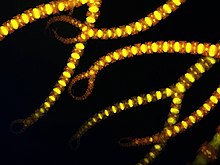Ceramium
| Ceramium | |
|---|---|

| |
| Ceramium virgatum | |
| Scientific classification | |
| (unranked): | Archaeplastida |
| Division: | Rhodophyta |
| Class: | Florideophyceae |
| Order: | Ceramiales |
| Family: | Ceramiaceae |
| Genus: | Ceramium Blume |
| Species | |
Ceramium is a genus of Ceramium algae (or Rhodophyta). It is a large genus with at least 15 species in the British Isles.[1]
The fully corticated group previously referred to as Ceramium rubrum, an illegitimate name, is represented, in the British Isles by: Ceramium pallidum, Ceramium botryocarpum, Ceramium nodulosum and Ceramium secundatum.[1][2]
Description
All species of Ceramium are small algae growing to no more than 30 cm (12 in) in length. They consist of a terete
rhizoids.[1]
Reproduction
The species is
spermatangia and carpogonia on separate male and female plants. The fertilised carpogonium develops growing parasitically attached to the female plant. Tetraspores are born in the cortical bands.[1]
Distribution

British Isles
England and Wales: Pembroke, Hampshire, Dorset, Devon and Cornwall, Sussex, Lincoln to Kent, Norfolk also the Channel Isles. Ireland: Cork, Kerry, Clare, Mayo, Waterford, Dublin, Donegal,[5] Antrim and Down.[1][2]World
Some species are probably cosmopolitan. Widely in north-west Atlantic, Iceland, Norway to Spain, Denmark, Netherlands, France, Portugal, Mediterranean, Azores, Canary Islands, Cape Verde Islands, USA - Newfoundland to New York, Australia.[1]
References
- ^ ISBN 0-11-310045-0
- ^ ISBN 0-900761-28-8
- ^ Newton, L. 1931. A Handbook of the British Seaweeds. British Museum (Natural History)
- ISBN 978-0-9955673-3-7
- ^ Morton, O. 2003. The marine macroalgae of County Donegal, Ireland. Bulletin of the Irish Biogeographical Society 27:3 - 164
External links
- https://web.archive.org/web/20060503234440/http://www.mbari.org/staff/conn/botany/reds/Ceramium/index.htm
- http://www.botany.hawaii.edu/ReefAlgae/ceramium.htm
